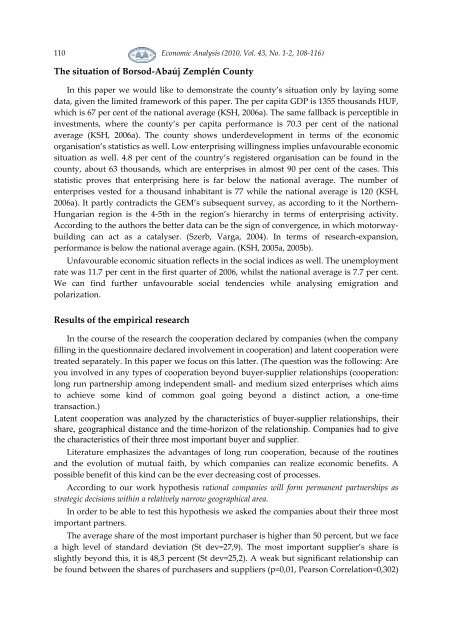Twice a Year Scientific Journal
Twice a Year Scientific Journal
Twice a Year Scientific Journal
Create successful ePaper yourself
Turn your PDF publications into a flip-book with our unique Google optimized e-Paper software.
110<br />
Economic Analysis (2010, Vol. 43, No. 1-2, 108-116)<br />
The situation of Borsod-Abaúj Zemplén County<br />
In this paper we would like to demonstrate the county’s situation only by laying some<br />
data, given the limited framework of this paper. The per capita GDP is 1355 thousands HUF,<br />
which is 67 per cent of the national average (KSH, 2006a). The same fallback is perceptible in<br />
investments, where the county’s per capita performance is 70.3 per cent of the national<br />
average (KSH, 2006a). The county shows underdevelopment in terms of the economic<br />
organisation’s statistics as well. Low enterprising willingness implies unfavourable economic<br />
situation as well. 4.8 per cent of the country’s registered organisation can be found in the<br />
county, about 63 thousands, which are enterprises in almost 90 per cent of the cases. This<br />
statistic proves that enterprising here is far below the national average. The number of<br />
enterprises vested for a thousand inhabitant is 77 while the national average is 120 (KSH,<br />
2006a). It partly contradicts the GEM’s subsequent survey, as according to it the Northern-<br />
Hungarian region is the 4-5th in the region’s hierarchy in terms of enterprising activity.<br />
According to the authors the better data can be the sign of convergence, in which motorwaybuilding<br />
can act as a catalyser. (Szerb, Varga, 2004). In terms of research-expansion,<br />
performance is below the national average again. (KSH, 2005a, 2005b).<br />
Unfavourable economic situation reflects in the social indices as well. The unemployment<br />
rate was 11.7 per cent in the first quarter of 2006, whilst the national average is 7.7 per cent.<br />
We can find further unfavourable social tendencies while analysing emigration and<br />
polarization.<br />
Results of the empirical research<br />
In the course of the research the cooperation declared by companies (when the company<br />
filling in the questionnaire declared involvement in cooperation) and latent cooperation were<br />
treated separately. In this paper we focus on this latter. (The question was the following: Are<br />
you involved in any types of cooperation beyond buyer-supplier relationships (cooperation:<br />
long run partnership among independent small- and medium sized enterprises which aims<br />
to achieve some kind of common goal going beyond a distinct action, a one-time<br />
transaction.)<br />
Latent cooperation was analyzed by the characteristics of buyer-supplier relationships, their<br />
share, geographical distance and the time-horizon of the relationship. Companies had to give<br />
the characteristics of their three most important buyer and supplier.<br />
Literature emphasizes the advantages of long run cooperation, because of the routines<br />
and the evolution of mutual faith, by which companies can realize economic benefits. A<br />
possible benefit of this kind can be the ever decreasing cost of processes.<br />
According to our work hypothesis rational companies will form permanent partnerships as<br />
strategic decisions within a relatively narrow geographical area.<br />
In order to be able to test this hypothesis we asked the companies about their three most<br />
important partners.<br />
The average share of the most important purchaser is higher than 50 percent, but we face<br />
a high level of standard deviation (St dev=27,9). The most important supplier’s share is<br />
slightly beyond this, it is 48,3 percent (St dev=25,2). A weak but significant relationship can<br />
be found between the shares of purchasers and suppliers (p=0,01, Pearson Correlation=0,302)
















